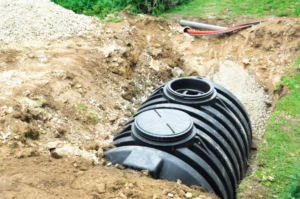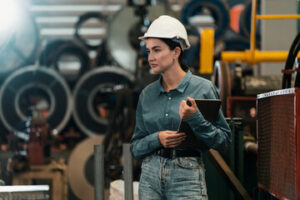A fence is a barrier that provides security, privacy, and marks property boundaries. It can also protect animals and crops from predators or weather, and enhance a home’s aesthetic appeal.
There are a variety of fence options, from wood to metal to composite. It’s important to understand your home’s needs and the potential drawbacks of each type of fence before you decide which one is right for you. Contact Renegade Fences & Farm now!

A fence is a barrier made of wood, stone, steel or other material used to enclose space and separate parcels of land. It may also act as a security measure or provide a visual or acoustic screen. Local regulations often dictate the height, material and placement of fences. Fences can be built on a private or public property, and may be erected for commercial, residential, agricultural or decorative purposes.
In the United States, most laws regarding fences are state-specific, and vary widely between jurisdictions. However, most impose some level of responsibility upon a landowner for maintaining a fence line on the property owner’s surveyed property line. The original laws regarding fences in the US were based on British common law, and were designed to prevent conflicts over land ownership. Fence laws in the western US grew out of the tradition of the open range, and were intended to prevent livestock roaming free on public lands by requiring landowners to fence their cattle in.
Fences may be constructed from a variety of materials, including wood, metal or vinyl. Wood-panel fencing, where finished wood planks are hung between posts to form a solid wall-like barrier, is a popular style of fence. Fences may also be made of other materials such as brick, stone and concrete. In addition, fences can be constructed out of living plants such as hedges, or cactus.
The most important element of a fence is its posts. These are the load bearing supports that hold up the rest of the fence, and must be strong enough to withstand weather conditions and other forces. There are three types of posts in a fence: terminal posts, corner posts and line posts. Terminal posts are located at the beginning and end of the fence line, while corner posts are placed at all points where the fence curves. Line posts are placed in between the terminal and corner posts to support the rest of the fence.
The term fence is sometimes used in the context of criminal activity to refer to a person or organization that buys stolen goods from a thief and sells them at a profit. This is illegal, and can carry significant legal penalties in many jurisdictions.
Purpose
A fence is a barrier that keeps out unwanted visitors, whether they’re animals or people. It’s also a great way to add privacy to your home. Especially if you live near a busy road or sidewalk, having a fence will help block the noise and traffic from your yard. Fences are also a great way to deter theft. They can keep thieves from sneaking into your property and stealing valuables. They can also keep children and pets from wandering off the property, which is a safety concern. Fences can also be used to protect plants and vegetables from hungry pests.
There are many different kinds of fences, each designed for a particular purpose. For example, a picket fence is a tall, decorative, wooden fence that separates a private garden from the rest of the yard. A deer fence is a more durable metal barrier that keeps deer from entering a garden.
Fences can serve as boundaries between properties, preventing disputes and encroachment between neighbors. They can also prevent theft of materials and equipment from construction sites and critical infrastructure. Fences can be installed around swimming pools to ensure the safety of children and pets. They can also be used to contain livestock and wildlife, ensuring that they are not disturbed by humans or other animals.
There is a common law duty on adjoining land owners to fence in their respective property. This obligation is imposed by agreement, statute, or prescription. If you don’t fence in your property, it can be disputed in court and you could end up with a lawsuit.
In the criminal context, a fence is a person who buys stolen goods and sells them at a profit. This can be done on the black market or in pawn shops. Some habitual thieves are known to work as fences, and law enforcement agencies work hard to tackle this issue. This may include undercover operations, posing as fences when buying stolen items, or monitoring fences at pawn shops to catch them in the act.
A fence can be an integral part of a landscape, providing a sense of enclosure and adding aesthetic appeal to the property. However, some fences are not practical for every situation and should be used with caution. Some people find that a fence is not enough to keep out trespassers or thieves, and that additional security measures should be taken. For this reason, it’s important to weigh the pros and cons of fencing before deciding to build one.
Materials
From the zigzag post-and-rail designs of Colonial times to today’s elaborately molded vinyl styles, fences come in a wide variety of materials. Each offers its own advantages and disadvantages, but choosing the right material for your needs is crucial. Homeowners who want to increase privacy and security often choose wood fencing, while those who want a classic European look opt for iron. Vinyl and aluminum offer a good balance of cost, beauty and durability, while steel chain-link is durable and can be inexpensive.
Metal fences can be heavy and difficult to move, so it’s important that they be professionally installed. This type of fencing is usually made of galvanised steel, which resists corrosion and provides a high level of protection against intruders. It also has a unique aesthetic that can be quite pleasing, and it’s easy to clean, making it a popular choice for swimming pool fencing.
Unlike many other types of fencing, steel is highly durable and can stand up to strong winds, although it’s not ideal for areas where children play. It’s a great option for industrial areas, though, and it can be coated with anti-corrosion layers to prolong its life.
Composite fences are a good alternative to wood and have the added benefit of being more weather-resistant. They also have a more natural aesthetic than cedar, but they’re not suitable for use around hot tubs. Unlike real wood, they don’t require a sealant, but occasional washes with water should be sufficient.
Wood fencing is a more traditional alternative to other materials, offering a timeless style that can be customised with painting or staining. It’s also a good option for people with allergies or sensitivity to chemicals, since it’s easy to clean and does not contain any harmful materials.
To protect the posts from damage and ensure that they stay firmly in place, concrete should be poured around each one. It’s important to follow the manufacturer’s instructions for mixing and curing time. Once the concrete is set, a post cap or finial can be added. These decorative items can help to make the fence more attractive and can also act as a deterrent for intruders.
Installation
The installation of a fence is a project that can be done by the homeowner, or with professional help. The first step is to plan the layout of the fence, taking into account property lines and local regulations. It’s also important to mark the location of any buried utilities. Once the layout is complete, stakes and string can be used to outline the fence path and ensure that it is aligned with property lines and avoids any obstacles. If the local code requires that a permit be obtained for fence construction, get this in advance so the process runs smoothly.
The next step is to dig the post holes. This can be done with a power auger or hand digging tool. Before digging, the area should be cleared of any large rocks or roots that could damage the fence or cause it to fall over. The holes should be dug at least 4 to 5 inches deep, and then filled with concrete. The concrete should be poured until it reaches just below the ground surface, and then leveled. A gravel base is usually added to provide a solid, stable foundation for the fence.
Once the posts are firmly in place, the next step is to add the fence rails. Depending on the type of fence, these can be 2x4s or pre-made panels. The rails should be attached to the posts with a sufficient number of wood screws to ensure that they remain secure over time. If a gate is planned, the gate posts must be prepared in advance to allow for hinges and latch hardware. Then the gate can be hung and braced to prevent it from sagging over time.
If the fence is made of pickets, it’s a good idea to stain or seal it to protect against moisture and sunlight. This will keep the wood looking nice and new, and it may even prolong its life. For chain link fences, the installer often stretches a bottom tension wire (also known as coil wire) between terminal posts to minimize in and out movement of the wire mesh between posts.


